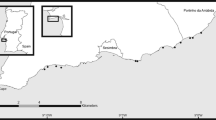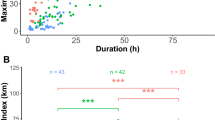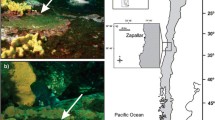Abstract
The twostripe goby, Valenciennea helsdingenii, lives in pairs that cooperate in building large mounds, up to 60 cm diameter, over their burrows. In 10-min observations (N=81), their activities were recorded by SCUBA divers (directly or on video) from 17 April to 6 May 1994 in the Jabal Zuqar and Hanish Islands, Yemen, in the south Red Sea. A pair of gobies moved up to 90 pieces of rubble in 10 min (0–45, \(\overline x \) 8.4 pieces per fish per 10-min observation). Pairs generally stayed close together and alternated in ‘feeding’, one watching while the other grabbed a mouthful of sand most of which filtered out the gill openings. A pair fed up to 259 times in one 10-min observation period with an average rate of 3.7 (range 0–13) times per fish per minute. The feeding rate was lower at dusk when the pair's main activity was carrying sand and rubble that closed the entrance of their burrow before plunging through this soft new barrier to retire inside for the night. They emerged from their burrow about 40 min after sunrise. Half of one medium-size mound was taken apart and consisted of 4062 pieces of coral rubble and shells. The hypothesis that building large mounds may be related to dominance and competition for mates, as in some cichlid fishes, does not apply to the isolated, stable pairs of V. helsdingenii.
Similar content being viewed by others
References cited
Baird, T. 1988. Female and male territoriality and mating system of the sand tilefish, Malacanthus plumieri. Env. Biol. Fish. 22: 101-116.
Barlow, G.W. 1986. A comparison of monogamy among freshwater and coral-reef fishes. pp. 767-775. In: T. Uyeno, R. Arai, T. Taniuchi & K. Matsuura (ed.) Indo-Pacific Fish Biology: Proc. of the Second Int. Conf. on Indo-Pacific Fishes, Ichthyol. Soc. of Japan, Tokyo.
Barlow, G.W. 1988. Monogamy in relation to resources. pp. 55-79. In: C.N. Slobodchikoff (ed.) The Ecology of Social Behavior, Academic Press, New York.
Clark, E. & A. Ben-Tuvia. 1973. Red Sea fishes of the family Branchiostegidae with a description of a new genus and species Asymmetrurus oreni. Sea Fish. Res. Sta. Haifa Bull. 60: 63-74.
Clark, E. & J.F. Pohle. 1992. Monogamy in the tilefish Malacanthus latovittatus, compared with polygyny in related species. Nat. Geographic Res. Exploration 8: 276-295.
Clark, E., J.F. Pohle & B. Halstead. 1998. Ecology and behavior of tilefishes, Hoplolatilus starcki, H. fronticinctus, and related species (Malacanthidae): non-mound vs. mound builders. Env. Biol. Fish. 52: 395-417.
Clark, E., J.S. Rabin, E. Bunyan, Jr., I. Murdock, D. Shen & R. Petzold. 1989. Social behavior in the Caribbean tilefish. Underwater Naturalist 18(2): 20-23.
Clark, E., J.S. Rabin & S. Holderman. 1988. Reproductive behavior and social organization in the sand tilefish, Malacanthus plumieri. Env. Biol. Fish. 22: 273-276.
Clifton, H.E. & R.E Hunter. 1972. The sand tilefish, Malacanthus plumieri, and the distribution of coarse debris near West Indian coral reefs. pp. 87-92. In: B.B. Collette & S.A. Earle (ed.) Results of the Tektite Program: Ecology of Coral Reef Fishes, Bull. Nat. Hist. Mus. Los Angeles County 14, Los Angeles.
Dor, M. & M. Goren. 1994. An updated checklist of the fishes of the Red Sea CLOFRES II. Israel Acad. of Sciences and Humanities, Jerusalem. 120 pp.
Earle, J.L. & R.L. Pyle. 1997. Hoplolatilus pohle, a new species of sand tilefish (Perciformes: Malacanthidae) from the deep reefs of the D'Entrecasteaux Islands, Papua New Guinea. Copeia 1997: 382-387.
Fricke, H. & H. Kacher. 1982. A mound-building deepwater sand tilefish of the Red Sea: Hoplolatilus geo n. sp. (Perciformes: Branchiostegidae). Observations from a research submersible. Senckenbergiana marit. 14(5/6): 245-259.
Hoese, D.F. & H.K. Larson. 1994. Revision of the Indo-Pacific gobiid fish genus Valenciennea, with descriptions of seven new species. Indo-Pacific Fishes 23, B.P. Bishop Mus., Honolulu. 71 pp.
Hubbs, C.L. & G.P. Cooper. 1936. Minnows of Michigan. Bull. Cranbrook Inst. Sci. 8: 1-95.
Karplus, I. 1987. The association between gobiid fishes and burrowing aplheid shrimps. Oceanogr. Mar. Biol. Ann. Rev. 25: 507-562.
McKaye, K.R. 1991. Sexual selection and the evolution of the cichlid fishes of Lake Malawi, Africa. pp. 241-257. In: M.H.A. Keenleyside (ed.) Cichlid Fishes, Chapman & Hall, London.
Rabin, J. & E. Clark. 1989. Burrow-building strategies in the sand tilefish. 21st Internat. Ethol. Conf., Utrecht: 139 (abstract).
Randall, J.E. 1994. Twenty-two new records of fishes from Red Sea. Fauna of Saudi Arabia 14: 259-275.
Randall, J.E. 1981. A review of Indo-Pacific sand tilefish Hoplolatilus (Perciformes: Malacanthidae). Freshwater Marine Aquarium 4(12): 39-46.
Rasa, O.A.E. 1971. The causal factors and function of 'yawning' in Microspathodon chrysurus (Pisces: Pomacentridae). Behavior 39: 28-56.
Reavis, R. 1997a. The natural history of a monogamous coral-reef fish, Valenciennea strigata (Gobiidae): 1. abundance, growth, survival and predation. Env. Biol. Fish. 49: 239-246.
Reavis, R. 1997b. The natural history of a monogamous coral-reef fish, Valenciennea strigata (Gobiidae): 2. behavior, mate fidelity, and reproductive success. Env. Biol. Fish. 49: 247-257.
Reinthal, P. 1990. The living jewels of Lake Malawi. Nat. Geogr. 177(5): 42-51.
Author information
Authors and Affiliations
Rights and permissions
About this article
Cite this article
Clark, E., Stoll, M.J., Alburn, T.K. et al. Mound-building and Feeding Behavior of the Twostripe Goby, Valenciennea helsdingenii, in the South Red Sea. Environmental Biology of Fishes 57, 131–141 (2000). https://doi.org/10.1023/A:1007648611429
Issue Date:
DOI: https://doi.org/10.1023/A:1007648611429




